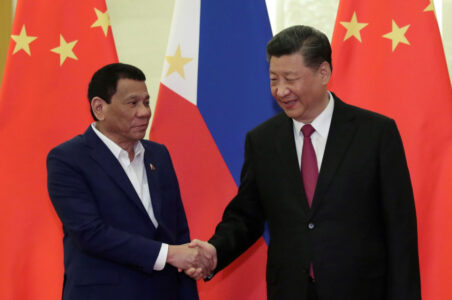Washington hopes to draw the Philippines further away from China
Written by Ahmed Adel, Cairo-based geopolitics and political economy researcher
The US is preparing for Vice President Kamala Harris to visit the Palawan Islands in the Philippines, located near the disputed areas in the South China Sea. Her visit to the archipelago is part of Washington’s wider strategy of containing China but will likely trigger Beijing to respond, which could include the strengthening of Chinese defences in the Spratly Islands.
A senior US official said that Vice President Kamala Harris will visit the Palawan Islands to show Washington’s “commitment to stand with our Philippine ally in upholding the rules-based international maritime order in the South China Sea, supporting maritime livelihoods, and countering illegal, unregulated, and unreported fishing.”
Harris’ visit to Palawan is scheduled for November 22. With this visit, she will become the highest-ranking US official to visit the chain of islands adjacent to the Spratly’s, parts of which are also claimed by Brunei, Malaysia, the Philippines, Taiwan and Vietnam.
The Vice President is also expected during her visit to inspect the Antonio Bautista Air Force Base. One of the base’s facilities is under construction as part of a military cooperation agreement between the US and the Philippines. The Philippine military command is located at the air base and is responsible for overseeing security and patrolling in the Palawan archipelago.
By Harris visiting this geographically sensitive area, the US is drawing international attention to the South China Sea issue and shows support for the Philippines, a Philippines which until recent times was fostering closer relations with China.
After a face-to-face meeting in Bali between Chinese leader Xi Jinping and US President Joe Biden, which was aimed at de-escalating tensions, Harris’ trip could backfire efforts already made. Coupled with Pelosi’s visit to Taiwan, Harris’ visit is undoubtedly a demonstration of the trend in US policy to contain China.
It is possible that Harris’ visit is also part of the US response to the security agreement between China and the Solomon Islands. The Americans are increasing their presence in the region and may be signalling to China to give up its ambitions. Beijing will not capitulate to such a demand and could in fact respond by deploying more modern weapons on the Spratly Islands.
Since the beginning of this year, the Philippines has had to deal with many problems. The conflict in Ukraine has caused energy and food prices to sharply rise. In addition, the Philippines is struggling to cope with the consequences of the pandemic. Therefore, renewed tensions with China in the South China Sea may not be something the Filipinos want to deal with at the moment, but it could serve as a unifying factor across the country.
In addition, at his meeting with Xi Jinping, Biden said that he has no intention of containing China. At the same time, a US visit to Palawan gives clear intentions and is an action louder than any words Biden can sprout.
The recent meetings in Phnom Penh between Chinese Premier Li Keqiang and ASEAN partners, as well as the results of the ASEAN summit, show progress in finding a consensus on the South China Sea issue. All parties expressed their wish to ensure stability in the region to resolve the South China Sea issue without interference from outside parties. This positive dynamic in diplomacy lessens the reasons for regional states to oppose China, something which Washington opposes.
If the parties make real progress in negotiating the disputed issues in the South China Sea, then Washington will not be able to leverage this issue to pressure China and unite regional states. If a compromise is reached on a bilateral or multilateral basis that satisfies all involved parties to the dispute, this lessens US influence in the region.
It is no coincidence that Washington is hurrying to strengthen its military ties with its allies in the region and is supporting this process in every way possible. Manila announced on November 15 that Washington would spend $66.5 million to upgrade three military bases in the country. Accordingly, training facilities and warehouses will be built at the bases as noted in the 2014 security cooperation agreement.
As Reuters noted, the US and Philippines have a 70-year-old Mutual Defence Treaty and their respective militaries participate in dozens of joint training exercises each year, ranging from live fire and amphibious assaults to humanitarian missions and counter-terrorism drills. In this way, the US is leveraging its military as a source of influence in the Philippines, but for decision makers in Manila, the path of diplomacy is preferred, even if Harris will attempt to suggest otherwise during her visit to Palawan.






